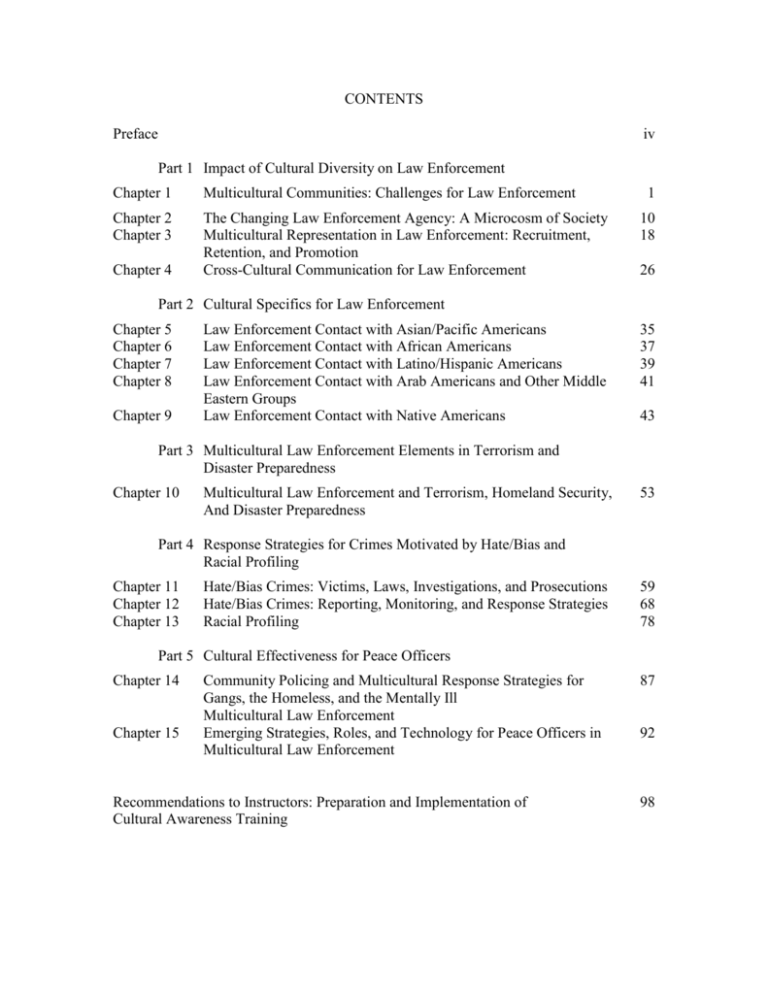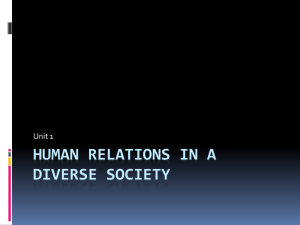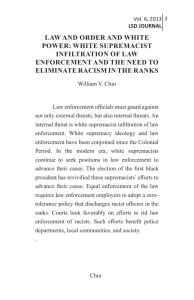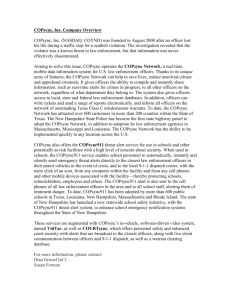Sample - solutionmanual center
advertisement

CONTENTS Preface iv Part 1 Impact of Cultural Diversity on Law Enforcement Chapter 1 Multicultural Communities: Challenges for Law Enforcement Chapter 2 Chapter 3 The Changing Law Enforcement Agency: A Microcosm of Society Multicultural Representation in Law Enforcement: Recruitment, Retention, and Promotion Cross-Cultural Communication for Law Enforcement Chapter 4 1 10 18 26 Part 2 Cultural Specifics for Law Enforcement Chapter 5 Chapter 6 Chapter 7 Chapter 8 Chapter 9 Law Enforcement Contact with Asian/Pacific Americans Law Enforcement Contact with African Americans Law Enforcement Contact with Latino/Hispanic Americans Law Enforcement Contact with Arab Americans and Other Middle Eastern Groups Law Enforcement Contact with Native Americans 35 37 39 41 43 Part 3 Multicultural Law Enforcement Elements in Terrorism and Disaster Preparedness Chapter 10 Multicultural Law Enforcement and Terrorism, Homeland Security, And Disaster Preparedness 53 Part 4 Response Strategies for Crimes Motivated by Hate/Bias and Racial Profiling Chapter 11 Chapter 12 Chapter 13 Hate/Bias Crimes: Victims, Laws, Investigations, and Prosecutions Hate/Bias Crimes: Reporting, Monitoring, and Response Strategies Racial Profiling 59 68 78 Part 5 Cultural Effectiveness for Peace Officers Chapter 14 Chapter 15 Community Policing and Multicultural Response Strategies for Gangs, the Homeless, and the Mentally Ill Multicultural Law Enforcement Emerging Strategies, Roles, and Technology for Peace Officers in Multicultural Law Enforcement Recommendations to Instructors: Preparation and Implementation of Cultural Awareness Training 87 92 98 PREFACE This manual is designed to accompany Multicultural Law Enforcement: Strategies for Peacekeeping in a Diverse Society, 5th edition. We have provided additional class topics, exercises for discussion, quizzes, and sources for further information. We have included notes to the instructor in order to highlight, update, or elaborate upon key points in the chapter. We hope that you will find the Instructor's Manual a helpful supplement to Multicultural Law Enforcement: Strategies for Peacekeeping in a Diverse Society. The instructor should also utilize the PowerPoint slides, online TestGen system for web-based tests and quizzes available from the publisher. THE CONTROVERSIAL TOPIC OF CULTURAL DIVERSITY IN LAW ENFORCEMENT From the authors' collective training experience in law enforcement, we advise instructors to expect resistance from some students to the topic of cultural diversity. As discussed in the first section of Chapter 1, some students may not see that there is anything special that needs to be addressed with regard to changing demographics. A sentiment among some officers may be, “Treat everyone fairly and with respect. Don't treat people differently just because of their background.” The instructor should put some thought into dealing with controversy in the classroom before beginning a course or training of this nature and he or she should establish guidelines with the students. Following are our suggestions: 1. 2. 3. 4. 5. 6. 7. Listen fully to the student's opinion, resisting the temptation to interrupt or disagree. Establish from the beginning of the class that students must give each other respect for diverse viewpoints; the instructor should be the first to model this respect. Establish that students can agree to disagree, but students must control the temptation to confront or accuse one another. Remind students that they themselves are a diverse group (point out: age, gender, ethnicity, education level, and geographic differences) and talk about how each person's respective background contributes to widely different perceptions, experiences, and reality. Point out that if students have a difficult time acknowledging the diversity of viewpoints in their own class in a professional manner, they may tend to become easily inflamed with citizens. Calm and controlled communication in class is good practice. Require that, as a skill that can be transferred to day-to-day policing, all students work on using communication skills to defuse conflict, rather than to escalate it. Remind students of the following if they continue to resist the importance of cultural diversity and its impact on law enforcement: a. Historically, the relations between minorities and police have been poor and this affects officer–citizen contact today. b. Dealing with citizens whose mother tongue is not English requires special ii c. d. understanding and skill in order for communication to be effective—this fact should have nothing to do with officers' views on the use of other languages (i.e., some students may put forth the argument that “they” are in this country now and should be speaking English. Whatever one's personal opinion is, reality calls for the necessity of communication with non—or limited English speakers). Many new immigrants do not generally understand the system upon their arrival in the United States and, therefore, require more time and patience from law enforcement personnel. Much modern-day prejudice toward minorities on the part of law enforcement officials has been documented. It is still a serious problem on the job and on the streets. While this obviously does not imply that all officers act on their prejudices, it is unrealistic to argue that prejudice in law enforcement is non-existent. Finally, some officers feel that the topic of cultural diversity in law enforcement training has received undue attention and is consistently overemphasized. It should be pointed out from the beginning of the training that the subject is a high priority subject along with many other topics. A breakthrough in law enforcement will be made when officers take it for granted that cultural diversity deserves a regular place in the curriculum. ISSUES REGARDING CULTURAL DIVERSITY TRAINERS AND INSTRUCTORS IN LAW ENFORCEMENT The individual selected to conduct cultural diversity classes in the law enforcement agency must not only be skilled at leading discussion, but must also be able to encourage open communication on racial, ethnic, lifestyle, and gender issues. This is achieved more easily if the class is heterogeneous, that is, if there are students of all backgrounds present. Keep in mind, however, that some classes should be divided by rank so that free communication can take place (i.e., a class with lieutenants or captains may result in sergeants not participating). The careful choice of instructors or trainers can prevent a backlash that has sometimes been sparked by cultural diversity training. Members of an organization who may feel threatened by the increased numbers of diverse employees (including women at the higher ranks) may perceive that the training is a vehicle designed to make people feel guilty because of past injustices. A good instructor will not create this impression and will avoid, at all costs, an “us versus them” approach (i.e., a blame approach). Instead, the instructor will emphasize the practical knowledge and skills that accompany crosscultural understanding, emphasizing, in particular, the increased officer safety, which results from positive interactions with citizens. Ideally, mixed teams (men and women, people from all racial backgrounds) should lead this instruction. Serious problems can arise when the following occurs: iii 1. 2. 3. 4. 5. 6. 7. 8. Training reflects a narrow view of which cultural differences should be valued (i.e., people from certain backgrounds feel that other cultures are valued more in the training than their own). Training appears to be a course in “political correctness” and not one that is truly designed to assist officers and students of law enforcement. Training is superficial and implemented as a result of a negative situation (e.g., a lawsuit against an agency, an investigation, etc.). Training is not connected to the organization's overall mission regarding diversity (or the agency has not even considered diversity as an organizational issue). Non-law enforcement trainers or community speakers have had conflicts with the police and a bias against police comes through in the training. Training is too theoretical or academic. Trainers/instructors do not model the philosophy or skills associated with a positive attitude toward diversity (e.g., joking about gays, using derogatory terms to define a group). Training is aimed at changing only one group of people, rather than looking at how people need to function together (e.g., in a multicultural workforce). The above warnings and precautions are not intended to discourage people from implementing cultural diversity in their training curricula. Rather, we wish to share observations and insights based on our professional involvement in this field. The majority of cultural diversity training programs succeed because officers and criminal justice students receive valuable information that assists them in responding to problems, differences, and customs for which they would otherwise be unprepared. We hope that the tips and key issues we have raised will contribute to your ability to create a positive learning environment for your students. iv CHAPTER 1 MULTICULTURAL COMMUNITIES: CHALLENGES FOR LAW ENFORCEMENT ----------------------------------------------------------------------------------------------------------Learning Objectives After completing this chapter, participants will be able to: 1. 2. 3. 4. 5. 6. 7. Discuss the impact of diversity on law enforcement. Understand the references “melting pot” and “mosaic” society, and provide a historical overview of the context in which these terms have evolved. Summarize key demographic trends in the United States related to growth of minority populations. Provide an overview of key issues associated with immigration directly affecting law enforcement. Define “culture” and “ethnocentrism” and discuss the contexts in which they are relevant to law enforcement. List the primary and secondary dimensions of diversity. Apply the concepts of prejudice and stereotyping to everyday police work. Outline of Key Presentation Points 1. 2. 3. 4. 5. 6. 7. 8. 9. 10. 11. Introduction Quotes on changing demographics Interface of diversity and law enforcement Definition of and reactions to diversity Immigrants, European Americans, undocumented immigrants, and foreigners in the U.S. Immigrant women: victims of domestic violence Definitions: multiculturalism, culture, race, ethnicity, ethnocentrism, bias, Prejudice, and Discrimination Interplay between police and culture Dimensions of diversity Prejudice in law enforcement Tips for improving law enforcement in multicultural communities PowerPoint Slides Fifty-one PowerPoint slides are provided on the Instructor Resource Center. These reflect the Key Presentation Points above. Optional Classroom Exercises or Class Activities/Discussion 5 The following activities supplement the discussion questions and issues at the end of the chapter: 1. Three Scenarios: Cross-Cultural-Police/Citizen Scenarios To further reinforce the idea that the growing diversity in our population has relevance to officers and other law enforcement personnel in their day-to-day work on the streets as well as in the workplace, the instructor can present the following three scenarios for discussion. In analyzing each one, whether in small or large groups, students/officers should keep in mind that they can react professionally and in ways that model cross-cultural tolerance and appreciation. Alternatively, poor choices and behavior, which do not model tolerance perpetuate the outdated stereotype of law enforcement as insensitive to the concerns of community groups and individuals from diverse backgrounds. Procedure for discussion and suggestions for action follow the three scenarios. a. The Cartoon: An African American officer complains to his shift supervisor that posted on one of the main bulletin boards in the squad room is a cartoon caricature with his name under it. The picture depicts a black male with a bone drawn through his nose. The caption under the picture thanked the officer for his willingness to “model the new department headgear.” This cartoon has been up for at least a day and everyone passes it on their way in and out of the main room. Therefore, at least a couple of supervisors have seen this cartoon. What should happen? b. Stereotypes and Suspicion: A call comes over dispatch that a security guard at a shopping mall in a predominantly white neighborhood has seen four Hispanic males. The security guard reports that they are gang members because they are all wearing matching leather jackets and red ball caps. He reports that they have just opened and closed their car trunk and are now entering the mall. The security guard notifies the merchants, some of whom immediately begin closing their stores. You are the officer in the vicinity of the mall who responds to the call just as the juveniles are leaving the mall and are heading toward their car. In the meantime, several merchants continue to be anxious about the “gang members,” leaving their stores closed. What should happen? c. Relations among Community Groups: You are a police officer in an agency that has been involved in community-oriented policing for several years. You are working in a neighborhood where there has been conflict between Korean Americans and African Americans. You have been summoned to a Korean American store where the Korean clerk has made a citizen's arrest on an African American youth for petty theft. A group of African Americans has gathered to protest the arrest. They are angry, but they are not hostile to you and your backup officer. There are several ways you could approach this multicultural community problem and some of the ways would probably ignite the 6 situation more than necessary. What do you think is the best way to handle the situation (i.e., with tact and sensitivity), given the animosity between the two groups? What should happen? Notes to the Instructor Procedure: Have students brainstorm (either in one large group or several small ones) what should happen in each of the following scenarios. When evaluating the students' responses, the instructor should consider how many of the following ideas the students discussed and should encourage additional creative suggestions made by students. Suggestions: The following are suggestions for dealing with the scenarios described above. The instructor may have to modify the suggestions based on laws, policies, and procedures of the students, officers, community, or workplace. 1. The Cartoon a. The supervisor listens respectfully and shows empathy to the African American officer; she/he asks if there have been other incidents. b. The supervisor reassures the officer that the matter will be investigated and appropriate discipline meted out if the responsible party is identified. c. The supervisor immediately removes the cartoon with the idea of identifying the responsible party (even if it takes dusting for fingerprints). d. The supervisor makes a full report and includes notes of interviews with the officer/employee whom he thinks is responsible. She or he finds out if there have been other incidents. e. The supervisor notifies his or her supervisor and submits a report. Notification continues up the chain of command to the chief of police. f. If there is an internal affairs investigator(s), a follow-up investigation should take place. g. Chief ranking officer (CRO) issues a memo to all employees advising generally that such actions (i.e., posting of racist cartoons) and racist/prejudicial behaviors will not be tolerated. h. CRO mentions departmental general orders covering fact that this occurrence violated department policy. Memo indicates that the person violating general orders will be disciplined immediately and that discipline will range depending on the severity of the violation. CRO may ask anyone with information to come forward. i. Where appropriate, the supervisor arranges for discussion among officers/employees affected. The supervisor encourages a dialogue between parties to increase awareness of the effects of the racist actions. j. The supervisor or manager looks through department training from the past year as it relates to diversity or ethics to see if this type of issue has been discussed. He or she makes sure that all training of this nature is documented (if not video taped) to counter an officer's assertion that “we never covered this.” 7 k. The supervisor should discuss the issue on every shift during briefings and staff meetings. He or she must emphasize strongly that this type of behavior will not be tolerated. 2. Stereotypes and Suspicion Officers do not have probable cause (PC) to stop Hispanic males to investigate possible crimes. Officers cannot detain Hispanics just based on how they are dressed. The officer's dilemma is that mall security/management and store owners will demand some action and will complain if nothing is done. Officers could: a. Record license number of the car and look through the windows to determine if there is anything suspicious inside that provides PC and run license plate for wants and warrants. b. Approach Hispanic males in a friendly manner and not as possible gang members and ask if they can talk about the store owners' and mall security's concerns. c. If they are cooperative, officers can simply request names and ask friendly, openended questions about what they are doing at the mall. d. Security and mall management should be interviewed: Did a crime occur? If not, they should be informed of what actions officers can legally take. e. Officers and security should inform stores that closed that no known crime has taken place; they should explain what officers can legally do and not do. f. Assuming there has been no trouble, officers can provide a small amount of “community education” by explaining to the parties concerned that many good kids are dressed like gang members, but should not be stereotyped. g. While advising security and store owners to remain cautious at all times, officers can model tolerance and non-prejudicial attitudes. h. The department should make sure that it has an ongoing positive relationship with the ethnic community involved and should, bringing in members from that community, offer a brief training to mall security and store owners. Community members should discuss stereotypes and law enforcement should present information on what to look for when identifying a gang member. This is a proactive and preventive approach to the problem. Note: In San Mateo, California, a shopping center settled a civil rights suit by agreeing not to discriminate against teens wearing “gang-style” clothing, and to pay $30,000 to four teenagers who say they were illegally ejected by security guards. The instructor could conclude the discussion of the scenario with this fact. 3. Relations among Community Groups a. In most states/localities, this youth can be released on a citation to appear in court (juvenile, or, if over 18, adult court). b. Scenario does not indicate age of youth—if younger than 18 years old, parent could be summoned to scene and youth released with citation/notice to appear in court. 8 c. Community-based policing involves the officer having contacts from various community groups. Officer should identify individuals from the Korean and African American community who can assist in mediating problems. Officer should not feel that she/he is the only solution in the conflict, but should welcome and encourage community members' help. d. Officer should listen to both sides—What does each side want? What are their grievances? Are there other problems that need to be investigated and addressed? e. Officer should document problems and tell parties what course of action will be taken. f. Officers should set date to meet with parties again and should get names for the follow-up. g. Officers can encourage community leaders to arrange to get together to brainstorm ways in which their respective communities can reduce tensions and conflicts. Wherever possible, officer should attend meetings and help to mediate. h. Officers need to realize that this is not an isolated event, i.e., there most likely have been issues and tensions leading up to the incident. The department management needs to put into place a “distant early warning system”* and should monitor community relations through the media and through communication with community leaders. i. After an incident of this nature, the department leaders should consider initiating a rally with members of both communities. The rally, with the police involved, would show the rest of the citizens that there is unity and that most individuals in the ethnic groups concerned want peaceful relations. * The authors wish to thank Retired Deputy Chief Ondra Berry of the Reno, Nevada PD for his ideas on the “early warning system.” He speaks of preventive, pro-active initiatives as “front-end programming” and positive actions taken after a negative incident as “back-end programming.” For example, in anticipation of trouble in Reno after the verdict in one of the most well known police brutality cases 2 decades ago (the Rodney King case), the chief of Reno PD initiated a rally and walked with community members of all races and ethnicities. Citizens had a direction for their reactions to the verdict and channeled their energy into peaceful protest. 4. Community Surveying The officer/student can continue to learn more about communities by surveying leaders and representatives in various communities. This type of exercise will reveal more than can be taught in a classroom setting and will complement the cultural information offered in this text. When community leaders are surveyed or interviewed, the following types of questions should be asked: a. What is the size of the group relative to the city's population? 9 b. c. d. e. What are the economic, social and political concerns of the group? What are their issues, if any, with law enforcement? How much contact, both positive and otherwise, do they have with law enforcement? What type of training should be offered to law enforcement in order for the community to be better understood? f. Which leaders and institutions should law enforcement know about if questions or the need for referrals arise? Notes to the Instructor The instructor may wish to expand upon the presentation regarding population similarities and differences by using additional census information available through the U.S. Census website (http://2010.census.gov/2010census/#3). Additionally, instructors can encourage students to research further the kinds of ethnic, cultural, and racial diversity which are unique to the local and regional community. Optional Student Assignments The Instructor may wish to assign for analysis and discussion the following: 1. 2. 3. Cases noted throughout the text’s chapters Questions for review and discussion in the Instructor’s Manual “Self Study Questions” and “Critical Thinking Questions” provided in the Student Guide, Concepts and Tools in Practice for Multicultural Law Enforcement Optional Student Projects The instructor may wish to assign one or more of the following topics: 1. 2. 3. 4. 5. Obtaining demographic data on multicultural communities Identifying cultural groups and community leaders Scanning for police and diverse community issues Developing community partnerships Issue in improving law enforcement in multicultural communities Testbank for Quizzes and Examinations (Available in the Online TestGen System for Web-Based Tests and Quizzes) True and False Questions Circle the questions that are false. 1. 2. 3. The word “multiculturalism” refers to a movement or political force. Although our nation has been enriched by diversity, many police procedures and interactions can be complicated by diversity. Developing “cultural competence” is a fairly quick process. 10 The strategies that one uses to build rapport with members of one’s own cultural group may result in unsuspected difficulties with members of another group. 5. The term “melting pot” has always referred to the blending of all cultural groups in America. 6. According to the authors, the terms “mosaic” and “tapestry” are not as effective descriptions of America’s multicultural society as the term “melting pot.” 7. Unlike today’s immigrant and refugee groups, nineteenth century immigrants’ acculturation to the United States was extremely smooth. 8. It is becoming increasingly difficult to categorize demographic groups because of the overlap between race and ethnicity. 9. Changes in population characteristics were insignificant between 1990 and 2000. 10. Every citizen in the United States is an immigrant from another country. 11. Of the foreign-born population in the United States, the largest group came from Asia in 2007. 12. Immigration always results in an economic downturn. 13. Officers must be aware of “racial flash points” that are created when immigrants move into economically depressed areas with large and diverse populations. 14. The principal barrier to establishing trust with undocumented immigrants is the language issue. 15. Law enforcement does not need to be too concerned about or involved with illegal immigration as the Immigration and Customs Enforcement (ICE) is in charge of this segment of the population. 16. Officers face challenges with relationship building with immigrants as all immigrant cultures reflect societies where citizens fear police. 17. Discretion regarding the taking of citizens into custody for lesser crimes may be appropriate when there is an extenuating cultural context for the crime. 18. Awareness and sensitivity to multicultural issues can have a significant impact on the criminal justice system in which police have the power to either inflame or calm citizens. 19. Discrimination is action based on prejudiced thought. 20. Prejudice that is unchecked and acted on can result in all of the following: citizen humiliation, lawsuits, loss of jobs, and long-term damage to police-community relations. 21. An officer or civilian employee who does nothing in the presence of racist or other discriminatory behavior by his or her peers becomes a silent accomplice in encouraging prejudice. 22. A primary dimension of culture would include a person’s occupation, level of education, and work style. 23. A secondary dimension of culture would include a person’s race, gender, and sexual orientation. 24. Workshops for Immigrants and Refugees on U.S. Police Laws and Emergency Services include instruction on topics such as: domestic violence, traffic and criminal laws, and appropriate responses if stopped by an officer. 25. The terms "illegal immigrant," "illegal alien," and "undocumented immigrant" are sometimes used interchangeably. 4. The following are false: 1, 3, 7, 9, 11, 12, 14, 15, 16, 22, 23 11 Multiple Choice Questions Read the question in italics and circle the appropriate answer(s). 1. According to a historian quoted in the text (Miller, 2006), diversity has always been a difficult proposition for most Americans. (Typical comments include all but which of the following statements?) a. “They don’t learn our language.” b. “They hold on to their cultures.” c. “They stimulate the economy.” d. “They form cliques.” 27. Chapter 1 contains the following quote by John F. Kennedy. “The _______ endured the scorn and discrimination later to be inflicted … on each successive wave of immigrants by already settled Americans. In speech and dress, they seemed foreign; they were poor and unskilled and they were arriving in overwhelming numbers…” (To which ethnic group is Kennedy referring?) a. Mexicans b. Vietnamese c. Irish d. Iraqis 28. Although racially and ethnically diverse groups have made progress with respect to indicators used to measure quality of life, they still face barriers to full inclusion in the United States. (Which of the following is not cited by the Advisory Board to the President’s Initiative on Race as an issue of Civil Rights for minorities?) a. Racial disparities and prejudices b. Differences in the rates of arrest, conviction, and sentencing between whites and minorities c. Unavailable data on racial and ethnic discrimination d. Racial profiling in law enforcement 29. The following are statements about the nature and influence of culture. (Which two statements from the text are correct?) a. Culture’s influences on the individual are at the conscious level b. People can usually describe their own cultural norms and values very well c. Culture is like an iceberg with most of its influences submerged “beneath the surface” d. Culture has a far greater influence on people’s behavior than such other variables as age, gender, race, and socioeconomic class 30. The three mini case studies in the chapter exemplify two of the following points. (Which two points are they?) a. The point of contact between law enforcement and citizens’ backgrounds must not be ignored 12 b. c. d. Officers must be encouraged to consider culture when investigating and presenting evidence regarding an alleged crime Standard operating procedures should be changed to take into consideration cultural differences Culture is a legitimate defense in heinous crimes 31. Europe has ________ different countries, each with a unique national government, and, for the most part, language. a. 25 b. 35 c. 45 d. 60 32. character, Racial disparities and prejudice affect the way in which minorities have been treated in the criminal system. (Which of the following are explicit examples of this?) a. Racial profiling b. Differences in rates of arrest between minority and non-minority citizens c. Differences in the rates of conviction and sentencing between whites and people of color d. Tendency among police officers not to speak out when peers use offensive language towards cultural or racial groups The correct statements are: 26c, 27c, 28c, 29c and d, 30a and b, 31c, 32a, b, and c 13





